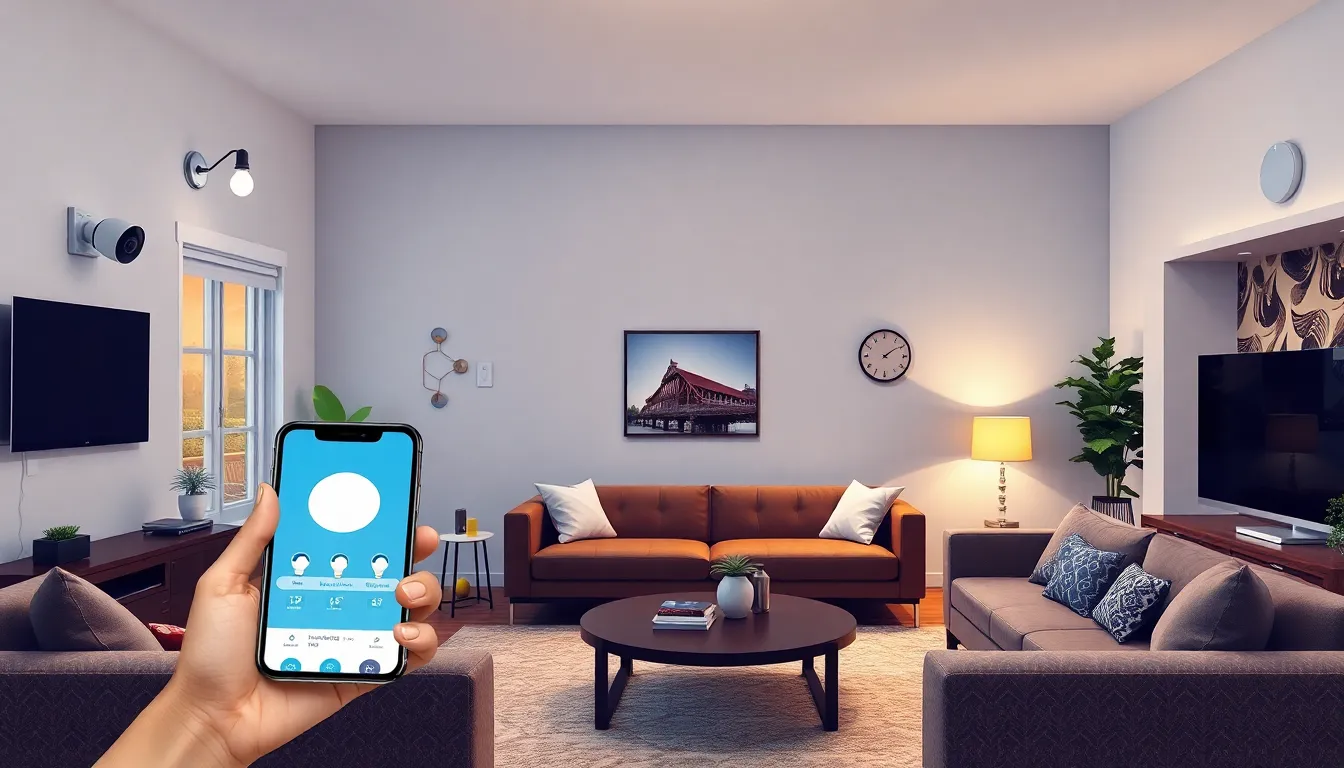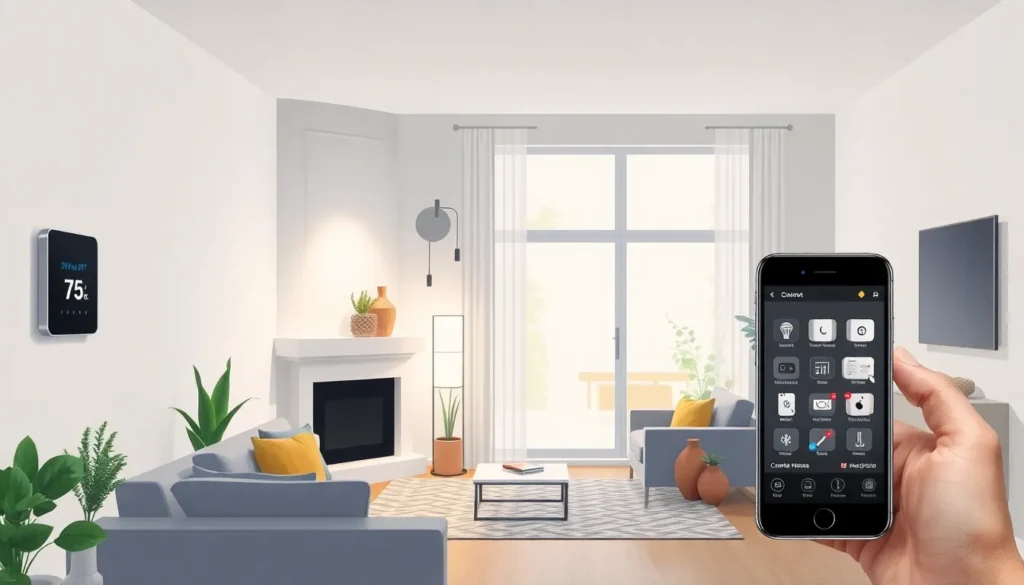Table of Contents
ToggleImagine walking into your home and having the lights turn on, the thermostat adjust, and your favorite playlist start playing—all without lifting a finger. Welcome to the world of home automation projects, where convenience meets creativity. Whether you’re a tech whiz or just looking to impress your friends with your futuristic pad, these projects can transform any ordinary space into a smart sanctuary.
Overview Of Home Automation Projects
Home automation projects enhance daily life by integrating technology into routine activities. These projects often include smart lighting systems that adjust based on occupancy. Many homeowners prefer smart thermostats that optimize energy use and maintain comfort.
Security systems gain increased attention, offering real-time monitoring and alerts. Smart locks enable keyless entry, providing both convenience and safety. Systems can also automate blinds and curtains, adjusting them according to sunlight or user preferences.
Entertainment systems feature prominently as well. Music can play automatically in response to specific activities, like preparing dinner or hosting a gathering. Multi-room audio setups allow seamless sound distribution throughout the home.
Homeowners appreciate the ability to control these systems remotely through smartphones. Most of these devices connect effortlessly with voice assistants, streamlining user interaction. They also offer customized settings, allowing inhabitants to create environments that suit their moods or needs.
Energy efficiency stands as a significant benefit of home automation. Using smart plugs provides insight into energy consumption and promotes eco-friendly practices. Some homeowners pursue projects focused on integrating solar panels into their systems, maximizing sustainability.
Innovative ideas lead homeowners towards projects like automated gardens or smart pet feeders. These add unique elements to the home environment and cater to specific interests. Ultimately, home automation projects transform households by creating comfortable, efficient, and enjoyable living spaces.
Popular Home Automation Projects

Home automation projects include a variety of solutions that enhance convenience and security in everyday life. Below are some popular categories.
Smart Lighting Solutions
Smart lighting solutions allow homeowners to control illumination through mobile apps or voice commands. Energy-efficient LED bulbs often connect to Wi-Fi networks. Occupancy sensors automatically adjust brightness based on human presence. Scheduling features enable lights to turn on and off at specific times. Systems can create personalized mood settings, enhancing entertainment experiences. Integration with smart home ecosystems improves overall functionality.
Home Security Systems
Home security systems offer real-time monitoring and advanced alerts. Smart cameras provide live feeds accessible from smartphones. Sensors detect movement and notify users instantly. Keyless entry systems increase convenience while enhancing security. Smart doorbells with video features facilitate communication with visitors remotely. Many systems allow for remote management, providing homeowners peace of mind.
Automated Climate Control
Automated climate control systems allow users to maintain optimal home temperatures efficiently. Smart thermostats adapt to user habits over time, learning preferences. Remote control capabilities make changes from anywhere possible. Scheduling functions help reduce energy consumption during off-peak hours. Integration with weather data enables proactive adjustments based on external conditions. Enhanced indoor air quality can also result from connected air purifiers working in harmony.
Tools And Technologies For Home Automation
Various tools and technologies play crucial roles in home automation projects. They enhance efficiency, convenience, and overall user experience in smart homes.
Essential Hardware Components
Smart devices serve as the backbone of any home automation project. Smart hubs connect components like lights, locks, and cameras, facilitating centralized control. Sensors monitor environmental changes, allowing for automated adjustments. Cameras enhance security by providing real-time surveillance that homeowners can access remotely. Smart plugs enable energy tracking and on/off control of appliances, boosting energy efficiency. These hardware essentials collectively provide a robust framework for creating seamless automated environments.
Software Platforms
Software platforms serve as the user interface for managing home automation systems. Applications connect various devices, allowing users to create custom routines and scenarios. Voice assistants, such as Amazon Alexa and Google Assistant, integrate seamlessly with multiple devices for hands-free control. Mobile apps provide remote access to all smart systems, ensuring constant monitoring, even when away from home. Many platforms offer compatibility with a wide range of devices, making it easier to expand automation capabilities over time. These software solutions enhance user experience while simplifying the complexity of controlling numerous devices.
Benefits Of Home Automation Projects
Home automation projects offer numerous advantages, enhancing daily life significantly. Convenience stands out; automation simplifies tasks, from adjusting lighting to setting the thermostat. Remote control makes managing these systems straightforward via smartphones, allowing users to adapt settings on the go.
Energy efficiency emerges as another key benefit. Smart thermostats learn user preferences, optimizing heating and cooling while reducing energy consumption. Implementing smart plugs helps track energy usage, promoting eco-friendly habits and potentially lowering utility bills.
Security gets a boost through automated systems. Real-time monitoring and alerts keep homeowners informed, while smart locks provide keyless entry for added safety. Integrating smart cameras enhances peace of mind, giving users the ability to check on their property from anywhere.
Customization plays a vital role in creating tailored living environments. Settings can be adjusted to suit specific moods or activities, such as dimming lights for movie night or adjusting the thermostat for comfort when entertaining guests. Automation can even extend beyond typical applications to include projects like automated gardens or smart pet feeders.
Technological integration further enhances these benefits. Home automation tools connect with voice assistants, making interaction seamless and user-friendly. Moreover, a solid foundation of critical hardware, such as smart hubs and sensors, facilitates smooth operation and interaction with various devices.
Social connectivity also increases, as homeowners can showcase their smart technology to friends and family. Providing a modern, impressive atmosphere enhances not only convenience but also lifestyle enjoyment. The innovation behind home automation projects continually evolves, offering fresh ideas and capabilities that transform living spaces into comfort-driven environments.
Challenges And Considerations
Implementing home automation projects presents various challenges. Compatibility issues frequently arise when integrating devices from different manufacturers. Ensuring seamless communication between smart devices requires careful selection of products that work together without conflict.
Cost is another important consideration. Some homeowners find initial investments can be significant, especially for comprehensive systems. Budget planning becomes essential to ensure the project remains financially viable.
Security also poses potential risks in home automation. Smart devices might be vulnerable to hacking, which could compromise personal data. Regular software updates and strong password practices help mitigate these risks.
Installation complexity should not be overlooked. Depending on the project scope, homeowners might need professional assistance. Gauge available skills and knowledge before undertaking complex installations.
User experience may vary significantly. Some individuals find smart systems intuitive, while others struggle with technology. Providing support and user-friendly interfaces is crucial for enhancing user satisfaction.
Energy efficiency must be considered as well. Selecting the right devices impacts both energy savings and overall utility costs. Review energy ratings and usage data to ensure optimal performance.
Future compatibility is vital for long-term planning. As technology evolves, integrating new devices may become necessary. Researching products that offer upgrade paths helps maintain system relevance and functionality.
Lastly, maintenance requirements play a role. Regular upkeep ensures devices function as intended and prolongs their lifespan. Set a schedule for routine checks and updates to promote seamless operation over time.
Home automation projects offer a transformative way to enhance daily living. They provide convenience security and energy efficiency while allowing homeowners to express creativity. By integrating technology into everyday tasks these projects create a seamless and enjoyable environment.
As innovation continues to advance the possibilities for home automation are virtually limitless. Homeowners can explore new ideas and solutions that cater to their unique needs. While challenges exist careful planning and informed choices can lead to successful implementations.
Ultimately embracing home automation not only elevates comfort but also fosters a modern lifestyle that adapts to individual preferences. The journey into smart living is just beginning and the future holds exciting potential for those willing to explore it.




